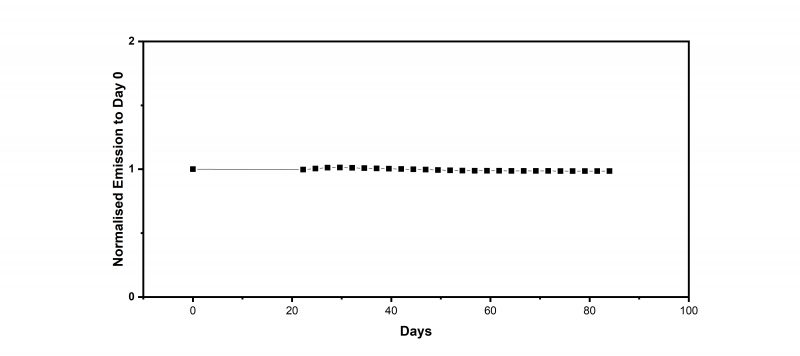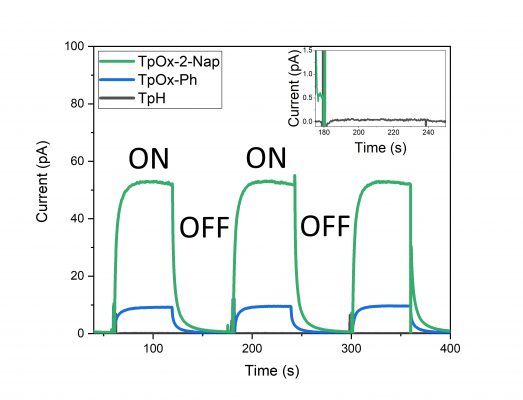ChromaTwist Technology
ChromaTwist technology patented donor-acceptor systems which leverages years of innovation and developed in Preece and Robinson group in University of Birmingham. To date ChromaTwist have synthesised ~100 compounds which has allowed us to obtain a detailed understanding of the molecular factors which control:
ChromaTwist technology allows chemically modify donor molecular structure in order to tune the absorbance for specific properties.
High absorption extinction coefficients – ~100 000 M-1 cm-1 and lmax, ~30 000 M-1 cm-1 @ 355 nm

Due to large aromatic area, ChromaTwist materials are suitable for multi-photon absorption experiments. To read more about this, go to Multiphoton Microscopy section.
ChromaTwist technology based on donor-acceptor system is very chemically flexible allows to incorporate different groups onto the molecular systems. Thus, to date ChromaTwist have over 100 different compounds with emission covering the whole visible spectrum from blue to red (with further development on-going to move redder).

ChromaTwist fluorescent materials have high fluorescence Quantum Yield (30-70%).
Coupled with a high molar absorptivity of ≈ 100000 which resulting in bright emission. This high brightness leads to a high sensitivity allowing for the detection of small quantities of fluorophore ≈ 10-9 M

ChromaTwist fluorescent materials have exceptional stability in solution for long periods of time.

ChromaTwist fluorescent materials have good solubility in a range of organic solvents.
ChromaTwist fluorescent materials can be dispersed in aqueous solvents and aqueous buffers via pre-dissolution in organic solvent such as DMSO.
ChromaTwist fluorescent materials are soluble in: Chloroform, Tetrahydrofuran (THF), Dichloromethane (DCM), Toluene, Cyclohexanone, Cyclohexane, Di-ethyl ether, Ethyl Acetate, Acetone.
ChromaTwist fluorescent materials show exception molecular stability in solid with most dyes having >250oC thermal stability.

ChromaTwist fluorescent materials have good processability into polymer matrices via spin coating, melting and 3D printing, whilst maintaining fluorescence.


ChromaTwist technology based on donor-acceptor system is very chemically flexible allows to incorporate different groups onto the molecular systems. Currently, ChromaTwist can incorporate reactive functional groups such as -CO2H, -N3, -NH2, -active esters, -SH, -alkenes, -Br.
Furthermore, ChromaTwist technology is versatile platform to create new fluorescent probes for analyte sensing application.
ChromaTwist fluorophores:
- Undergo fluorescence quenching in the presence of electron deficient aromatics
- Undergo fluorescent modulation upon binding metal cations in an appended crown ether moiety
- Undergo fluorescence shifts upon modulation of the subphase pH




ChromaTwist materials display Hexagonal Columnar Discotic Liquid Crystal (DLC) mesophases – a state of matter intermediate between liquid and solid. This mesophase gives rise to an anisotropy in photophysical properties such as light polarisation, light emission and charge transport. In addition, ChromaTwist materials are able to form nanoparticles and nanowires.


In addition, ChromaTwist materials are able to form nanoparticles and nanowires.

Triphenoxazoles are organic insulators with charge mobility around ~ 10-3 cm2/Vs. When irradiated with UV light, ChromaTwist materials become photoconductors. The photocurrent display up to 2 orders of magnitude increase compared to the hexakis(alkyloxy)triphenylenes (TpH), which is the archetypical photoconductor.

